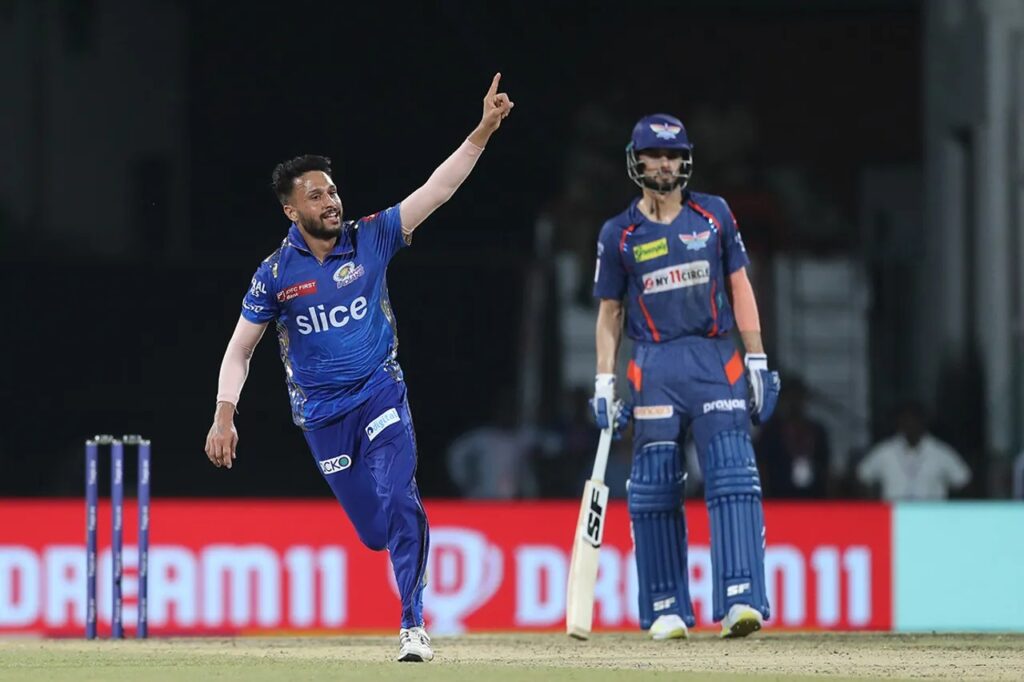
Akash Madhwal was just a couple of weeks short of his 26th birthday when he first represented his state. In an era where talents are identified by the time they’re in their teens, and then fast-tracked through age-group teams, his career trajectory has been decidedly unusual. On May 24, Madhwal put his name up in lights at one of Indian cricket’s most storied venues, finishing with scarcely believable figures of 5-5 at Chepauk to scuttle Lucknow Super Giants’ hopes in the IPL’s Eliminator round.
We can talk at length about the Mumbai Indians’ team environment, and the scouting network that identifies such talent. We can also discuss the calmness with which Rohit Sharma leads, and the confidence that he gives even the most junior players. But Madhwal’s remarkable rise is also the story of Indian cricket’s transformation, and the pivotal role that the Indian Premier League (IPL) has played in that.
There’s a chance that Madhwal may never play for India. But even without that treasured cap, he can still be a household name. He can earn enough to look after his family and loved ones. The IPL has given wings to dozens of such dreams, and there are many more Madhwals waiting for their turn.
For the first 60 years or so of India’s existence as an international-cricket-playing nation, stardom was very much the preserve of the Test cricketer. The likes of BB Nimbalkar, Rajinder Goel and Padmakar Shivalkar had plenty of admirers among their peers, but the man on the street would have struggled to recognise them. The contrast with someone like Abbas Ali Baig, whose first-class record was fairly modest, was stark.
Baig played only ten Tests and finished with an average of 23.77, but the century he made on debut as a 20 year old at Old Trafford in 1959 ensured that he became one of Indian cricket’s first post-independence pin-up boys. There were others too. ML Jaisimha made three Test hundreds, and Salim Durani just one. But by virtue of playing Test cricket for India, they became the heroes of millions.
Even if you look at the World Cup-winning side of 1983, there’s really no one you would class as a one-day specialist. Krishnamachari Srikkanth, with his whiplash drives and cuts, may have been the early prototype for the generations of attacking openers that followed, but he also made two hundreds in a 43-Test career.
Also Read: Like CSK, Mumbai Indians Showcase the Winning Mentality
It was only well into the 1990s that players started to be picked specifically for their white-ball skills. Atul Bedade, the six-hitting Baroda bat, was one such, though the bowling attacks still tended to be made up of Test stalwarts until someone like Debasis Mohanty came along and hooped the ball around for a brief while, especially in the Sahara Cup matches against Pakistan in Toronto.
But even when Dinesh Mongia, an ODI specialist – albeit with an excellent first-class record – was picked ahead of VVS Laxman, one of the fulcrums of India’s Test batting, for the 2003 World Cup, there was uproar from experts and fans alike. White-ball cricket was still easily dismissed as a ‘lesser’ skill, never mind that players needed to constantly reinvent themselves to stay ahead of the game.
The IPL provided a big tent for those who weren’t necessarily all that adept at the red-ball format. It made heroes of those who could clear the ropes with ease, or bowl the cleverly disguised knuckle ball. Under Shane Warne’s captaincy, Swapnil Asnodkar became the ‘Goa Cannon’, and an integral part of the side that won the first IPL.
Shadab Jakati, his teammate at state level, shone for Chennai Super Kings in both the 2010 and 2011 finals. In 2009, when the IPL had to move to South Africa, it was the unknown Harmeet Singh that dismissed both Rahul Dravid and Mark Boucher as the now-extinct Deccan Chargers edged out Royal Challengers Bangalore in the final.
Who can forget Paul Valthaty’s blistering hundred in the 2011 edition, or Manvinder Bisla’s dashing 48-ball 89 that led Kolkata Knight Riders to their first title in 2012? Even when Gujarat Titans won the tournament at the first time of asking last season, the unheralded duo of Yash Dayal and R Sai Kishore played a big part in restricting a strong Rajasthan Royals’ line-up to a below-par total in the final.
Cricket fans love nostalgia. We love to speculate which of the heroes of the past, the six-hitting Durani being a prime example, would have thrived in the IPL. But the beauty of the league lies in the fact that it has created household names of those who aren’t necessarily going to play for India.
For too long, the limelight was reserved for 15 to 20 who wore the Indian crest on their chests. But the IPL’s lights have reached once-dark corners and highlighted the efforts of many others. The Madhwals of the world deserve these minutes and hours of fame. And thanks to the IPL, they won’t be the last.
Also Read: Madhwal’s Dream Spell Scuttles Lucknow as Mumbai Indians March On



